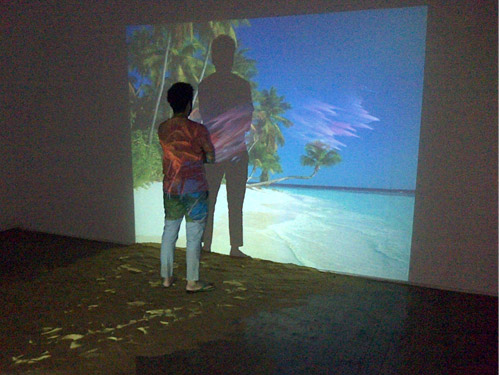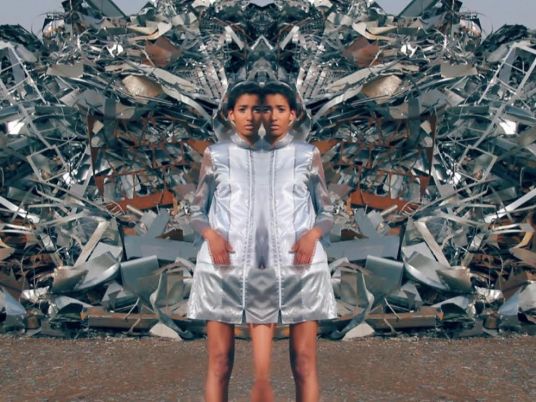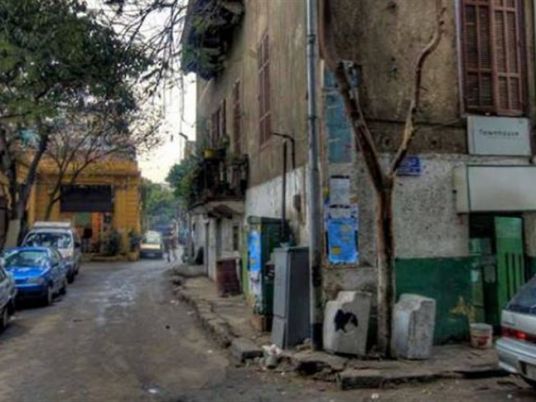
Internet art can bypass galleries, museums and the money that gives the art world its glamorous hierarchy of exclusivity. People who make Internet art often stick to their Internet communities, while those who overly concern themselves with the history, theory and institutions of art can lose the Internet’s chaotic freedom.
A small, two-week show at Townhouse that ended Wednesday brought into the gallery works by four artists, most of whose digital practices are usually exhibited on the Internet. In the show, all the works were presented as completely silent looped sequences and looked a bit like dreamy screensavers.
While Internet art is often interactive, in that the user can click and make things change (for example jodi.org), any interaction with the works in “IRL” was of the more traditional gallery kind: physically moving through and around a display, as a viewer rather than as a user.
With “IRL” – the title of which stands for “in real life” – curator Ania Szremski (who is also a contributor and editor at Egypt Independent) sought to show that the “sublime virtual space” of the Internet “may not be something so alien and separate from an organic one.”
Thus two of the works involved organic materials. Alexandria McCrosky’s work, “experiencing deep personal grief,” consisted of two monitors and a pile of hay, which was apparently meant to lend a nestlike, protected feel, but in reality was somewhat unnerving to walk on. The images in the slide shows on each monitor were like nostalgic double-exposed photographs on which small computer generated designs were superimposed. Visually, they were reminiscent of some of Wolfgang Tillmans’ photography.
Islam Shabana’s work, “Zen Beach,” was two overlapping projections on the wall with some sand on the floor underneath, the bumps in the sand catching some of the projected light. One projection, the largest, was of a common kitschy palm tree screensaver, the only moving element being the water lapping at the beach. The other projection was a .gif animation of a cloudy, cascading pinkish blob. If you walked between the screensaver projector and the wall, the cloudy .gif-blob would cascade on your body, and your shadow would appear on the beach.
Sabrina Ratté’s “Activated Memory” – maybe the hardest to describe of all the works in “IRL” – was a quite beautiful six-and-half-minute loop that was a sort of revolving collage of trees, landscapes and a cube, with sections of 3D animation. Its colours were very 1980s and it reminded me of David Lynch’s TV series, “Twin Peaks.”
Elna Frederick had two pieces in the show, one in Townhouse’s first floor gallery with the others, and one by itself in the gallery’s factory space. The two were quite similar – pulsing pixelated curvy patterns – but downstairs, her “((())) Place” was simultaneously shown on a normal sized screen and also projected onto the huge back wall of the space, spilling onto the floor and four pillars on its way. This spelt out the concurrent virtual and physical presence that the exhibition sought to explore.
Unlike with "normal" artworks, information about the date and medium of each piece were not provided, but nor were any URLs. Having been appropriated for a curatorial idea, they were cut off from the online world that most of them belonged to, shown in an institution that otherwise doesn’t seem very interested in the possibilities of the Internet – Townhouse’s online presence is pretty old-school and patchy.
Frederick, McCrosky and Ratté belong to internet art community platform computersclub.org. You can see the “experiencing deep personal grief” images without the hay here, “((())) Place” here, and “Activated Memory” here with a soundtrack that didn’t make it into the show.
Szremski explained that she got into net-based art when she was studying for her MA at the School of the Art Institute of Chicago, where there is a strong computer arts community. She said she likes that such works are “flexible and fun, not serious” and that “finding interesting ways to curate this stuff is a pet interest of mine.”
The show did seem playful, and that playfulness worked best with Shabana’s piece, which indeed did not seem to actually be internet art, but rather incorporated elements of net art in a projection art piece that looked like it was meant for a gallery. The humorous meeting of the virtual white sand and the yellow, coarse sand of reality, and the way the viewer’s body could be inserted into the piece, meant it was most worthy of a gallery encounter.
Perhaps what was more interesting than the attempt to bring out the works’ physicality, though, was the kind of work the exhibition represented; for some people who saw it, like myself, the exhibition might be a gateway to the fascinating world of internet art. And that world (bubblebyte.org is another good site) can be explored from any computer.




